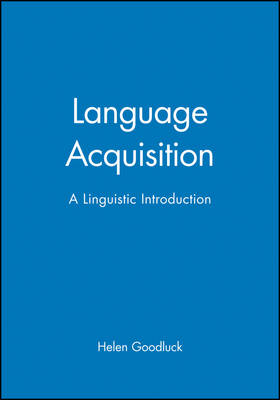
Language Acquisition
Wiley-Blackwell (Verlag)
978-0-631-17386-1 (ISBN)
This text is an up-to-date introduction to language acquisition, designed to meet the needs of advanced undergraduates and beginning graduate students in linguistics and cognitive science. It is the first language acquisition text to be written from the perspective of recent theoretical linguistics, and uses Chomskyan generative grammar as a framework for description. Taking models and analyses from generative phonology, morphology, syntax and semantics, Professor Goodluck describes children's language acquisition using examples from a variety of languages. Further chapters take up central questions concerning cognitive mechanisms by which children process language and form rules, the nature of the input to the language learner, and the relation between language development and other aspects of cognitive development. The book is extensively illustrated with models and figures, and each chapter is followed by questions for discussion and suggestions for further reading. It also includes a full bibliography.
Helen Goodluck is Associate Professor of Linguistics at the University of Ottawa.
Preface and Acknowledgements. 1. Introduction: Linguistics and Language Acquisition.
1.1.Knowledge of Language: Competence and Performance.
1.2. Types of Linguistic Knowledge.
1.3. The Projection Problem.
1.4. Universal Grammar.
1.5. Outline.
Notes.
Further Reading.
2. Phonological Acquisition.
2.1. Speech Sounds.
2.1.1. How Sounds are Made.
2.1.2. Features.
2.2. Phonetics, Phonology and Language Variation.
2.3. Categorical Perception in Adults and Infants.
2.4. Early Speech Sounds.
2.5. Feature Acquisition.
2.6. Child Phonologies.
2.6.1. Segmental Rules.
2.6.2. Suprasegmentals.
2.7. Problems and Ideas.
2.8. Summary and Conclusions.
Notes.
Further Reading.
Questions and Exercises.
3. Morphological Development and Innovation.
3.1. Types of Morphological Rules.
3.2. A Morphological Model.
3.3. Children's Knowledge of Level Ordering.
3.4. Rule Use and Innovation.
3.5. Problems and Unknowns.
3.6. A Cross-Linguistic Perspective.
3.7. Summary and Conclusions.
Questions and Exercises.
4. The Acquisition of Syntax.
4.1. Syntactic Structures and Universal Grammar.
4.1.1. Basic Syntax.
4.1.2. Levels of Representation.
4.1.3. Universal Grammar: Principles and Parameters.
4.1.4. Modules of Government Binding Theory.
4.1.5. Government Binding Theory and the Acquisition of Syntax.
4.2. The Outer Course of Development.
4.3. Early Syntax.
4.3.1. Early Phrase Structure.
4.3.2. Subjectless Sentences.
4.4. Syntax in Pre-School Years.
4.4.1. Children's Knowledge Of the Binding Theory.
4.4.2. Bounding Theory and the Development of Movement.
4.4.3. Children's Grammar of Control.
4.4.4. Summary.
4.5. Syntactic Development after Age Six.
4.6. Syntactic Development: Some Popular Ideas Reconsidered.
4.6.1. 'Semantics First'.
4.6.2. 'Syntax is Late'.
4.7. Summary and Conclusions.
Notes.
Further Reading.
Questions and Exercises.
5. Further Aspects of Syntactic and Semantic Development.
5.1. The Auxiliary System of English.
5.1.1. Auxiliary Verbs and Morphological Endings.
5.1.2. Negation and "Do" Support'.
5.1.3. A Syntactic Analysis.
5.2. The Acquisition of Auxiliary Systems: Syntax.
5.3. The Acquisition of Negation.
5.4. An Aside on Developmental Orders and Individual Development.
5.5. The Acquisition of Modality, Tense and Aspect.
5.5.1. Modality.
5.5.2. Tense and Aspect.
5.6. The Development of Word Meanings.
5.6.1. Word Meanings.
5.6.2. The Semantic Feature Hypothesis.
5.6.3. Challenges to the Semantic Feature Hypothesis.
5.7. Quantification and Logical Form.
5.8. Summary and Conclusions.
Note.
Further Reading.
Questions and Exercises.
6. Cognition, Environment and Language Learning.
6.1. Innateness.
6.2. Input and Errors.
6.3. The Role of Universal Grammar in Language Development.
6.4. Learnability and Acquisition Principles.
6.4.1. Subjacency and Degree-n Learnability.
6.4.2. The Subset Principle.
6.5. Summary: Components of a Learning Model.
6.6. Some Questions and Problems in Acquisition Theory.
6.6.1. Markedness and Orders of Acquisition.
6.6.2. Continuity or Maturation?.
6.6.3. Parameter Setting vs. Hypothesis Testing.
6.7. The Limits of the Linguistic Model: Lexical Learning.
6.8. Motherese.
6.9. Language Development and Cognitive Development.
6.9.1. Specificity and the Logic of Learning.
6.9.2. Constructivism and Developmental Orders.
6.10. Summary and Conclusions.
Notes.
Further Reading.
Questions and Exercises.
7. Performance Development.
7.1. Estimating Competence.
7.2. Adult Processing Mechanisms.
7.2.1. A Model.
7.2.2. Grammar vs. General Knowledge and Strategies.
7.2.3. Words-to-Message Processing.
7.3. Children's Sentence Processing.
7.3.1. On-line Computation of Syntactic Structure.
7.3.2. Strategies and Children's Comprehension.
7.3.3. Resolution Strategies.
7.4. Discourse Integration.
7.5. Summary and Conclusions.
Notes.
Further Reading.
Questions and Exercises.
Bibliography.
Index.
| Erscheint lt. Verlag | 6.6.1991 |
|---|---|
| Reihe/Serie | Blackwell Textbooks in Linguistics |
| Verlagsort | Hoboken |
| Sprache | englisch |
| Maße | 174 x 248 mm |
| Gewicht | 397 g |
| Themenwelt | Geisteswissenschaften ► Philosophie ► Sprachphilosophie |
| Geisteswissenschaften ► Sprach- / Literaturwissenschaft ► Sprachwissenschaft | |
| ISBN-10 | 0-631-17386-2 / 0631173862 |
| ISBN-13 | 978-0-631-17386-1 / 9780631173861 |
| Zustand | Neuware |
| Haben Sie eine Frage zum Produkt? |
aus dem Bereich


